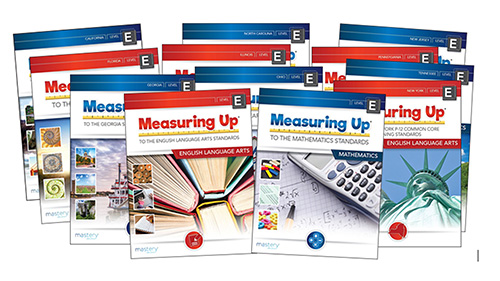6 Unique Exit Tickets to Use with Your Students
An exit ticket can be an effective way to determine if students are understanding what they are being taught. They provide immediate feedback, while...
AP & Honors Mathematics
Explore Wiley titles to support both AP and Honors mathematics instruction.
Literacy Skills & Intensive Reading
Connections: Reading – Grades 6–12
Empower student success with a proven intensive reading program that develops strong reading skills in striving readers.
Drama, Speech & Debate
Basic Drama Projects 10th Edition
Build students’ confidence and competence with comprehensive, project-based theatre instruction.
Literature
Connections: Literature
Support learners as they study dynamic, relevant texts and bring the richness of diverse voices to students through literature.
Literature & Thought
Develop critical thinking, reading, and writing across literacy themes, genres, historical eras, and current events.
Language Arts
Vocabu-Lit® – Grades 6–12
Help students build word power using high-quality contemporary and classic literature, nonfiction, essays, and more.
Connections: Writing & Language
Help students develop grammar, usage, mechanics, vocabulary, spelling, and writing and editing skills.
Reading/English Language Arts
Measuring Up to the English Language Arts Standards
Incorporate standards-driven teaching strategies to complement your ELA curriculum.
English Language Learners
Measuring Up for English Language Learners
Incorporate research-based best practices for ELLs with an approach that includes a focus on language acquisition strategies.
Mathematics
Measuring Up to the Mathematics Standards
Incorporate standards-driven teaching strategies to complement your mathematics curriculum.
Foundations
Measuring Up Foundations
Help students master foundational math skills that are critical for students to find academic success.
Science
Measuring Up to the Next Generation Science Standards
Give students comprehensive NGSS coverage while targeting instruction and providing rigorous standards practice.
Assessment
Measuring Up Live
Deliver innovative assessment and practice technology designed to offer data-driven instructional support.
For a better website experience, please confirm you are in:
National Dropout Prevention Center’s evaluation of Measuring Up reveals students experienced substantial academic progress
Overview
During the 2016–17 school year, the National Dropout Prevention Center/Network conducted a year-long study of the Measuring Up program and its impact on student outcomes measured by both Measuring Up Live 2.0 – Insight and state-administered assessments. The focus of the evaluation was to determine the effect of both the digital Measuring Up Live 2.0 program and the print Measuring Up Instructional Worktexts on both ELA and Mathematics scores. Two methods were used for this evaluation:
In all schools, Measuring Up Insight scores were used to measure growth in ELA and Mathematics, and state-administered assessment scores were used to measure growth in Mathematics. The results of this study revealed that the Measuring Up program positively affects learning goals and better prepares students for ELA and Mathematics assessments.
Quantitative Findings
Student scores were collected pre- and post-program to assess gains over the school year. Measuring Up Live 2.0 – Insight scores were gathered for ELA and Mathematics before implementation and near the end of the program usage as a post-assessment. A range of grade levels from 4 through 8 were assessed in ELA and Math at each school.
State-administered Mathematics assessment scores from the previous school year were used as a pre-program benchmark, and then post-program growth was measured using scale scores from the 2016–17 school year.
Qualitative Findings
In addition to providing assessment results, evaluation of the program included classroom observations and questionnaires. Overall, both students and teachers were satisfied with their experience using Measuring Up (print and digital) and felt that they were better prepared for tests in ELA and Mathematics. Students indicated that the digital program was easy to use, especially in areas where they struggle with the material, and they appreciated the immediate feedback provided by the program. In open-ended questions, students liked that the program “helps me understand things better” and that it “tells me what I got wrong and gives me a hint, and then I can try again.” One student indicated that Measuring Up is “fun, easy, and helps my ability to do better.”
Teachers also felt that the program was easy to use and that they would benefit from additional professional development for the program, a service provided by the Measuring Up implementation team. Teachers were appreciative of the print materials when technology was unavailable due to connectivity or bandwidth. The overwhelming majority of teachers agreed that their students were better prepared for assessments because of Measuring Up.
Factors That May Predict Positive Outcomes
Implementation varied significantly from school to school and from classroom to classroom. Teacher training prior to implementation of the program was found to be a significant attribute towards success. All four schools saw gains in student achievement, regardless of implementation and training scenarios. In addition, students tended to prefer the digital version of the program. However, since access to technology in some classrooms was limited, teachers often gravitated to the print materials. The blended solution (print and digital) that Measuring Up offers promotes differentiated instruction and independent practice, and allows for various coaching techniques in the classroom. As shown by the study, struggling students displayed substantial academic growth, even with differing levels of implementation, participation, and access to technology.
Complete findings within the National Dropout Prevention Center/Network Measuring Up Evaluation Technical Report can be found on our website, www.masteryeducation.com/research.html.
How Curriculum-Based Assessment Improves Education
As public schools are increasingly expected to be accountable for student progress measurements, educators know just how critical it is to perform periodic assessments. Educators can use assessments to measure how well students perform on the curriculum and progress towards standards mastery. Data from assessment results provide educators with valuable knowledge to pinpoint areas in which students need additional work and modify or target curriculum to ensure student success.
Educators employ curriculum-based assessments (CBA) to understand student progress and to differentiate curriculum to student needs. Many educators benefit from the use of measurement tools and tracking resources to leverage CBAs to the advantage of their students and schools.
How CBA Work
Students are expected to master several curriculum objectives over the course of an academic year. CBAs simply allow educators to measure student progress along the way. The technique links instruction with assessment and enables teachers to “specify instructional goals.”
Students learn in a variety of manners (with some exhibiting differing learning styles by subject), so it is important to adapt to students’ needs to ensure their success. CBA evaluations are often performed weekly. They are brief and offer insight into student progress so that teachers can adjust their methodologies and adapt to the students’ needs. Also, providing measurable, real-time, and actionable data is critical to success.
Examples of CBA in Action
According to the National Association of Elementary School Principals, nearly 30 years of empirical evidence show that CBAs are an effective, scientific strategy for improving student performance. However, teachers are often skeptical of CBA techniques, much of which could be due to educators being unsure of how to implement the strategy.
Many examples demonstrate that educators are effective when equipped with curriculum-based measurement (CBM) tools. Special education teacher Candyce Ihnot has been using CBAs in her classroom for 22 years. Although originally skeptical, Ihnot is now an advocate of the strategy because she has the necessary tools. In her experience, CBAs give her the following teaching advantages.
Mr. Smith, an elementary reading teacher, learned to use CBA evaluations along with typical assessments like unit tests and projects. CBAs, he explains, differ from other forms of testing because they allow him to measure student progress on specific skills. For example, he uses CBAs to track student reading fluency and adapts his instruction to the exact struggles students face with this skill.
Implementing CBA
CBAs are such effective and vital techniques for educators; thus, it is important to provide tools to help effectively implement them. Tools that provide standardized measurements can help educators group students based on support needs or targeted interventions.
In Measuring Up Live 2.0, educators not only have access to assessments written to meet the rigor of their state’s testing but also robust data and reporting. Real-time, actionable reporting helps measure student performance, growth, and standards proficiency. Students even have access to their own reporting dashboards, putting them in control of their success and growth. By providing educators with real-time results, they can prescribe automatic practice within the adaptive practice section of the program, modify their instruction, or target intervention to the skills deficiencies each student needs.
Learn more about how Measuring Up Live 2.0 can help educators effectively implement CBAs today.

An exit ticket can be an effective way to determine if students are understanding what they are being taught. They provide immediate feedback, while...

Preventing the “winter slide” starts with keeping key skills fresh and giving students purposeful, bite-sized practice before they head out...

As an educator, there might be one question you dread above all others: “But when am I ever going to use this?”

Summer is almost here. For many, it’s a time to relax and leave schoolwork worries behind. However, by the time school starts up again in the fall,...

Spring is in the air, and school children all across the nation are entering the last leg of the academic year. But before the final bell rings, many...

In a 2004 Gallup survey, history and social studies ranked as the least popular subject for teenagers. Why is this? Many adults recount history class...

Congratulations—or maybe condolences? You just found out you are teaching an Advanced Placement® (AP) English class next year. Whether it’s AP...

A key challenge for educators is finding a way to customize and differentiate learning for each student in their classrooms. Teachers need tailored...

In American K-12 public schools, English language learners (ELLs) make up over 10% of students. 10% may not sound like much, but that’s over 5...

Having a comprehensive and well-designed curriculum at your fingertips will go a long way toward creating summer enrichment activities that engage...

Taking high-stakes assessments can be a stressful experience for students. But the right practice tools can help alleviate the pressure and even make...

